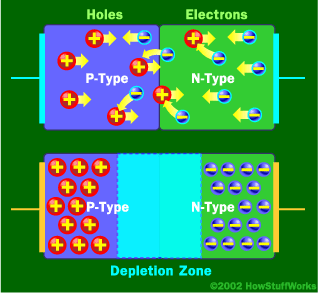As I mentioned earlier, diodes are made of one or more atomic elements to make a special semiconductor material. This special semiconductor material is what makes the physical properties of a diode so unique and useful. The semiconductor diodes are made of are usually made of different combinations of silicon, gallium, aluminum, and arsenide injected with several impurities. This process of injecting impurities into these pure elements is called doping.
Once the doping process is complete a diode can fulfill its purpose. The process creates two layers that these diagrams from HowStuffWorks.com can help you understand. These two layers are properly named P-Type and N-Type. Each layer is created by injecting a specific impurity into the layer, giving it the special ability to contain a concentration of protons (P-Type) and electrons (N-Type). You now probably find it obvious that they named these layers by the charges (Positive and Negative) they contain. Each layer represents a terminal of the diode, to be connected to any part of an electric circuit.

Above - The electron/proton activity in active state and the electron/proton alignment in its insulating state.

